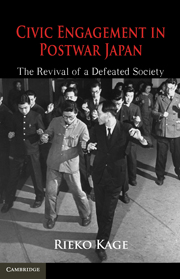Book contents
- Frontmatter
- Contents
- List of Tables
- List of Figures
- Preface
- Acknowledgments
- Civic Engagement in Postwar Japan
- 1 Introduction
- 2 Civic Engagement: The Dependent Variable
- 3 War and Civic Engagement: A Theoretical Framework
- 4 Quantitative Analysis: The Rise of Civic Engagement across Forty-Six Japanese Prefectures
- 5 The Long-Term Effects of Wartime Mobilization: Cross-National Analysis
- 6 Repression and Revival of the YMCA Japan
- 7 Wartime Endorsement and Postwar Repression of a Traditional Art
- 8 Civil Society and Reconstruction in Postwar Japan
- 9 Conclusions
- References
- Index
4 - Quantitative Analysis: The Rise of Civic Engagement across Forty-Six Japanese Prefectures
Published online by Cambridge University Press: 06 December 2010
- Frontmatter
- Contents
- List of Tables
- List of Figures
- Preface
- Acknowledgments
- Civic Engagement in Postwar Japan
- 1 Introduction
- 2 Civic Engagement: The Dependent Variable
- 3 War and Civic Engagement: A Theoretical Framework
- 4 Quantitative Analysis: The Rise of Civic Engagement across Forty-Six Japanese Prefectures
- 5 The Long-Term Effects of Wartime Mobilization: Cross-National Analysis
- 6 Repression and Revival of the YMCA Japan
- 7 Wartime Endorsement and Postwar Repression of a Traditional Art
- 8 Civil Society and Reconstruction in Postwar Japan
- 9 Conclusions
- References
- Index
Summary
OVERVIEW
Chapter 2 presented new data on the rise of civic engagement in Japan in the wake of World War II. It demonstrated that, contrary to standard expectations, Japan experienced a sharp rise in levels of civic engagement in the initial decade after the war across several different types of groups. This rise was well under way even before economic growth had begun to take off. At the same time, Chapter 2 also showed the presence of considerable variation in the extent of this rise across different Japanese prefectures. To explain these findings, Chapter 3 took a step back from the Japanese case per se to rethink the more general relationship between war and civic engagement. It offered a new theoretical framework that focuses on how experiences of mobilization during wartime equip citizens with new skills that they can apply with renewed vigor after war's end, particularly if preexisting legacies from the prewar period permit the rapid revival of organizations and help to disseminate information on those groups.
The next four chapters test the validity of the framework presented in Chapter 3. The present chapter uses quantitative analysis to assess the explanatory power of the hypothesis on the change in levels of civic engagement between the prewar and postwar periods in Japan at the prefectural level. Chapter 5 then moves beyond the Japanese case and again uses quantitative analysis to test the broader applicability of the framework on thirteen countries that were affected by World War II. Chapters 6 and 7 then return to the case of Japan and perform process-tracing analyses of specific groups in particular cities, illuminating the causal mechanisms that could not be captured by the quantitative analyses in Chapters 4 and 5.
- Type
- Chapter
- Information
- Civic Engagement in Postwar JapanThe Revival of a Defeated Society, pp. 64 - 77Publisher: Cambridge University PressPrint publication year: 2010



